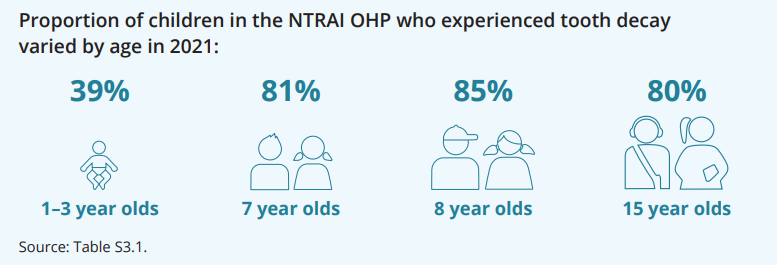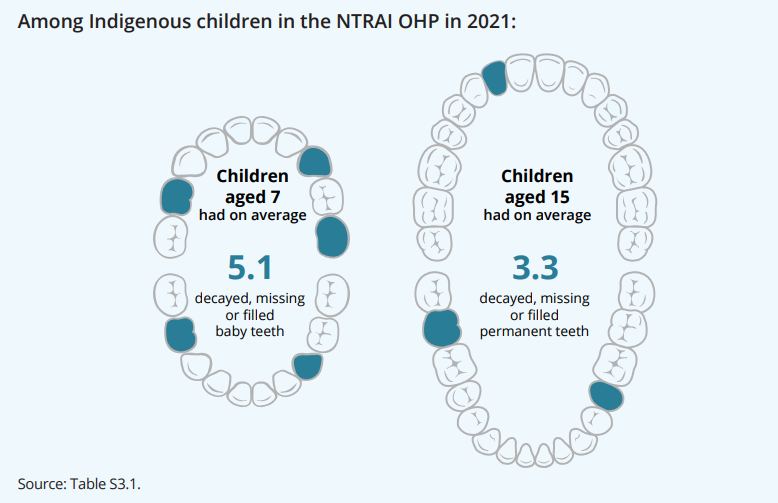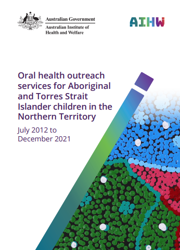Summary
Oral health is an important part of overall health and quality of life. Poor oral health can affect adults and children alike, causing pain, embarrassment, even social marginalisation. For children, the effects can be long-term, and carry through to adulthood.
Aboriginal and Torres Strait Islander children are more likely than non-Indigenous children to experience tooth decay. Several factors contribute to the poorer oral health of Indigenous children, including social disadvantage and lack of access to appropriate diet and dental services.
Since 2007, the Australian Government has helped fund oral health services for Indigenous children aged under 16 in the Northern Territory. The Northern Territory Remote Aboriginal Investment Oral Health Program (NTRAI OHP) complements the Northern Territory Government Child Oral Health Program by providing preventive (application of full-mouth fluoride varnish and fissure sealants) and clinical (tooth extractions, diagnostics, restorations and examinations) services.
This report presents data from the NTRAI OHP from July 2012 to December 2021.
How many Indigenous children received services in the NTRAI OHP?
In 2021, full-mouth fluoride varnish services, fissure sealant applications and clinical service visits were provided to Indigenous children in the Northern Territory under the NTRAI OHP. Of those children:
- 5,118 received 6,422 full-mouth fluoride varnish services, an increase of 937 services from 2020
- 1,319 received fissure sealant applications to 5,261 teeth during 1,408 services, an increase of 1,074 teeth from 2020
- 2,447 received clinical services during 3,026 visits (excluding 2,186 visits classified as urban) – such as dental assessments, fillings, extractions, or preventive services – a similar number of visits as in 2020.

How many Indigenous children experienced tooth decay in the NTRAI OHP?
Tooth decay varied by age, and in 2021, children aged 8 experienced the highest rate of tooth decay (85%). In comparison, children aged 1–3 experienced the lowest rates of tooth decay (39%).

How many decayed, missing or filled teeth did Indigenous children have?
A widely used indicator to measure oral health status is a count of the number of decayed, missing or filled teeth.
On average, in 2021, children in the NTRAI OHP aged 7 had the highest average number of decayed, missing or filled baby teeth (dmft), at 5.1 teeth, while children aged 15 had the highest average number of decayed, missing or filled permanent teeth (DMFT), at 3.3 teeth.

What was the impact of COVID-19?
Between 2019 and 2020 the number of full-mouth fluoride varnish services, fissure sealant applications and clinical service visits decreased. This was largely due to a fall in attendances between March and April 2020, coinciding with the introduction of restrictions imposed to control the spread of COVID-19. The services started to increase again in 2021 which might be the result of fewer restrictions, for full-mouth fluoride applications (937 applications) and for fissure sealant applications (1,074 applications).
Is the program meeting its benchmarks?
Outcomes for the NTRAI OHP are monitored through performance indicators and benchmarks. In 2021, COVID-19 restrictions might still have affected services delivered. Of the three service types, two of them were met (Table S1).
| Service delivery targets | Outcomes |
|---|---|
|
At least 3,800 clinical service visits per year |
5,212 clinical service visits* |
|
At least 9,553 fluoride varnish applications in 2021 |
6,422 fluoride varnish applications provided |
|
Fissure sealant applications to at least 2,500 teeth in 2021 |
Fissure sealant applications to 5,261 teeth |
|
Health outcome targets: |
66% of total service items were preventive in 2021 |
* Clinical urban services were included from 2020, therefore benchmark data are not comparable with years before 2020.
Summary
1. Introduction
2. Dental service delivery
3. Oral health status
4. Progress against benchmarks
Appendix A: About the Northern Territory Remote Aboriginal Investment Oral Health Program data collection
Appendix B: Data quality statement
End matter:
Acknowledgments; Abbreviations; Glossary; References; List of tables; List of figures; Related publications.



